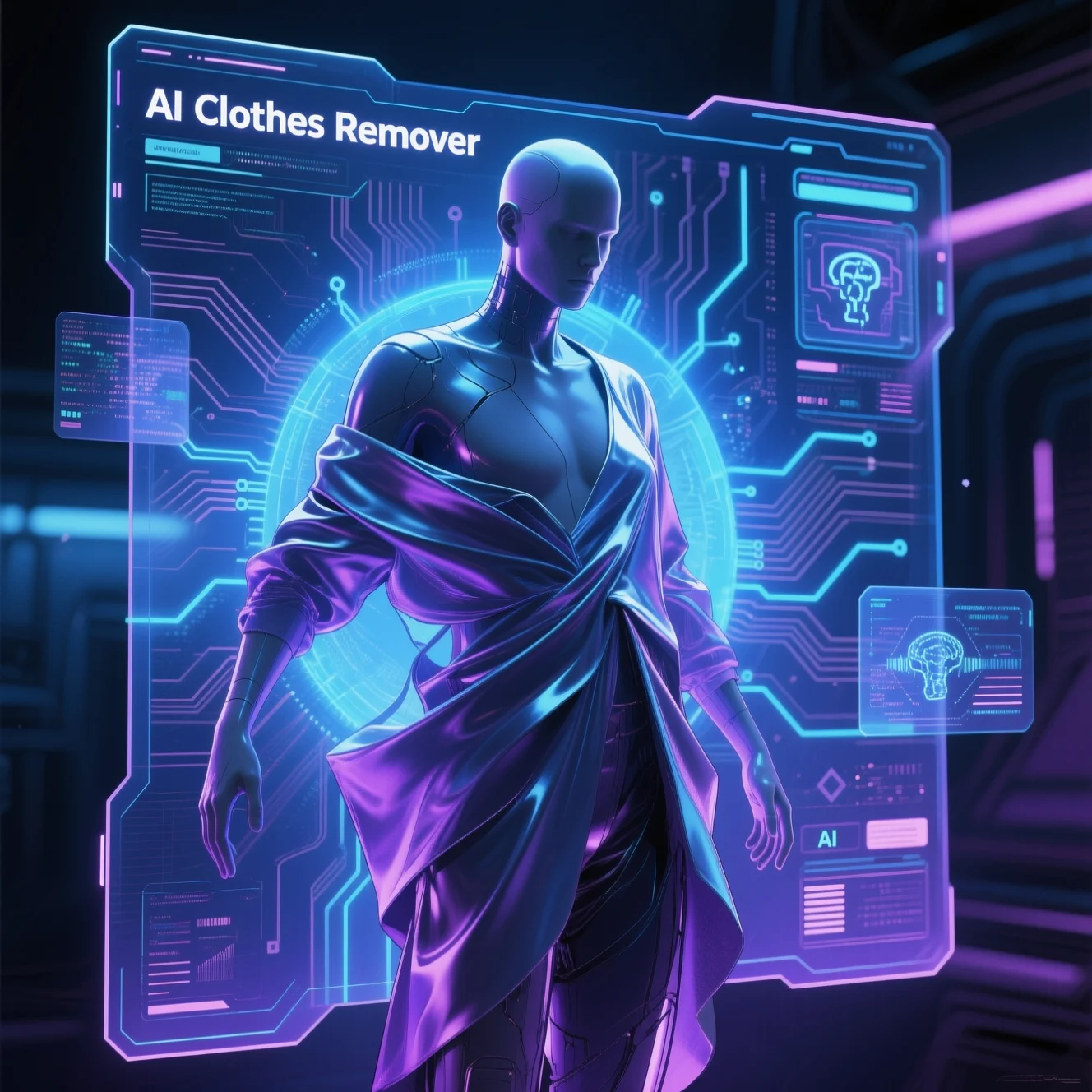Imagine tweaking a photo to swap outfits or visualize a new design in seconds—AI makes it possible. AI clothes remover tools have exploded in popularity by 2025, transforming how we edit images for fashion, art, and more. These tools use cutting-edge artificial intelligence to digitally remove or replace clothing in photos, offering a blend of creativity and convenience.
But with great power comes great responsibility. This blog post dives deep into AI clothes remover technology, exploring how it works, the best tools available, legitimate use cases, ethical concerns, and practical tips for getting the most out of these tools. Whether you’re a designer, e-commerce seller, or curious creator, you’ll find everything you need to know about AI clothes remover apps right here.
What Are AI Clothes Remover Tools?
AI clothes removers are software applications that harness artificial intelligence to manipulate images by removing or altering clothing. Unlike traditional photo editing, which requires hours of manual work in Photoshop, these tools automate the process with remarkable precision. They’re built for creative fields like fashion design, virtual try-ons, and digital art, but their capabilities spark both excitement and caution.
At their core, AI clothes remover tools rely on advanced machine learning algorithms. These algorithms analyze an image, identify clothing, and either remove it or replace it with new outfits. The results? Seamless edits that look natural, not like a clumsy cut-and-paste job. For example, a designer can upload a photo of a model in a bulky coat and, with a few clicks, see them in a sleek dress—all without reshooting.
Here’s what makes these tools tick:
- Neural Networks: These mimic human brain patterns to process images, learning from vast datasets to predict body shapes under clothing.
- Generative Adversarial Networks (GANs): Two AI models compete—one generates the image, the other critiques it—ensuring hyper-realistic results.
- Image Segmentation: This pinpoints clothing boundaries, so the AI knows exactly what to remove or swap.
- Inpainting: After removing clothing, the AI fills in gaps with realistic skin tones or new fabrics, preserving lighting and shadows.
By 2025, these tools have become so sophisticated that they can handle complex poses, varied lighting, and even group photos. But don’t be fooled—these tools don’t “see” beneath clothes; they predict and generate based on trained data, which is why ethical use is critical.
How AI Clothes Removers Work
Curious about the magic behind AI clothes remover online tools? It’s like a digital tailor with a supercomputer brain. The process is surprisingly simple for users, but the tech under the hood is a marvel of engineering. Here’s how it works in plain English:
You start by uploading a photo to an AI clothes remover website or app. The AI scans the image, using computer vision to detect clothing. It then removes or replaces the clothing based on your instructions, reconstructing the image with natural textures. Finally, you can tweak the results with text prompts or manual adjustments for perfection.
Let’s break it down step-by-step:
- Image Upload: You drop a high-resolution photo into the platform. Clear, well-lit images work best.
- Clothing Detection: The AI uses image segmentation to outline garments, distinguishing them from skin or backgrounds.
- Removal or Swap: Algorithms erase the clothing and inpaint the area with realistic skin or a new outfit.
- Refinement: Some tools let you fine-tune via prompts like “replace jacket with t-shirt” or manual brushing for precision.
The tech relies on:
- Deep Learning Models: Trained on millions of images, these models understand body contours and fabric textures.
- Dynamic Lighting Sync: Ensures shadows and highlights match the original photo for a natural look.
- Muscle Memory Algorithms: Preserve muscle definition and limb curves, avoiding awkward distortions.
For instance, imagine uploading a beach photo of someone in a cover-up. You type “remove cover-up, add bikini.” In seconds, the AI clothes remover tool delivers a photorealistic image of the person in a bikini, with natural skin tones and lighting. It’s fast, but the quality depends on the tool and image clarity.
Top 5 AI Clothes Remover Tools in 2025
With so many AI clothes remover apps out there, picking the right one can feel overwhelming. Based on user reviews, web research, and performance, here are the top five tools in 2025, judged on realism, ease of use, privacy, and platform compatibility. Each offers unique strengths for different needs, whether you’re a pro designer or a casual user.
AVCLabs PhotoPro AI
This desktop-based tool shines for privacy-conscious users. It processes images locally, meaning your photos never hit the cloud. AVCLabs supports text-prompt clothing changes and handles multiple image formats like JPG and PNG. It’s ideal for fashion designers who need secure, high-quality edits.
- Pros: No cloud uploads, versatile for complex edits, supports outfit swaps.
- Cons: Paid credits for extended use, requires decent hardware.
- Best For: Professionals prioritizing data security.
- Price: $29.95/month or $149.95 one-time purchase (2025 pricing).
Fotor AI Clothes Remover
Fotor’s browser-based AI clothes remover online tool is a beginner’s dream. With preset outfit options and a face-swap feature, it’s perfect for quick, creative edits. You can swap a model’s jacket for a dress or even add muscles for a fitness vibe. Its intuitive interface requires no design skills.
- Pros: User-friendly, high-quality presets, fast processing.
- Cons: Limited free credits (10/month), slower with weak internet.
- Best For: Casual users and social media creators.
- Price: Free tier; premium at $8.99/month.
Undress.app
Known for speed, Undress.app delivers results in 4–5 seconds. It offers modes like lingerie or bikini swaps and supports both male and female images. However, its cloud-based nature raises privacy concerns, so use it cautiously.
- Pros: Fast, intuitive, versatile for quick edits.
- Cons: Requires signup, potential privacy risks.
- Best For: Users needing rapid results for simple projects.
- Price: Free trial (5 credits); premium from $5.99/month.
Myimg AI Clothes Remover
Myimg focuses on one-click clothing removal, making it a go-to for simplicity. It auto-detects clothing without needing prompts, delivering decent results in seconds. However, it’s less flexible for outfit swaps compared to competitors.
- Pros: No prompts needed, free tier (10 uses/day), fast.
- Cons: Limited to removal, results can look AI-generated.
- Best For: Quick, no-fuss clothing removal.
- Price: Free; premium at $9.99/month for unlimited use.
Pxbee Free AI Clothes Remover
Pxbee’s browser-based tool requires no login, making it accessible for budget users. It supports text-prompt outfit generation and a brush tool for precision. It’s great for casual edits but struggles with complex backgrounds.
- Pros: No signup, maintains natural lighting, free.
- Cons: Manual brushing often needed, weaker with busy scenes.
- Best For: Budget-conscious users needing quick browser edits.
- Price: 100% free.
Here’s a comparison table for clarity:
| Tool | Realism | Ease of Use | Privacy | Platform | Best For |
|---|---|---|---|---|---|
| AVCLabs PhotoPro AI | ★★★★☆ | ★★★★☆ | High | Desktop | Secure edits |
| Fotor | ★★★★☆ | ★★★★★ | Moderate | Web/Mobile | Beginners |
| Undress.app | ★★★★☆ | ★★★★☆ | Moderate | Web | Quick edits |
| Myimg | ★★★☆☆ | ★★★★☆ | Low | Web | Simple removal |
| Pxbee | ★★★☆☆ | ★★★★☆ | Moderate | Web | Budget users |
These tools cater to different needs, so choose based on your priorities—privacy, speed, or versatility.
Legitimate Use Cases for AI Clothes Removers
AI clothes remover software isn’t just about gimmicks; it has practical, ethical applications across industries. From fashion to fitness, these tools streamline workflows and spark creativity. Here are the top legitimate use cases:
- Fashion and E-commerce:
- Virtual try-ons reduce returns by letting customers see outfits on their body type.
- Example: Zara uses AI clothes remover tools to display a dress on various models without new shoots, cutting costs by 30% (2025 industry estimate).
- Retailers create diverse product catalogs from a single model photo.
- Digital Art and Content Creation:
- Artists use tools like Fotor to remove clothing and design custom costumes for games or animations.
- Example: A digital artist swaps a character’s armor for a futuristic suit, saving hours of manual editing.
- Medical Visualization:
- With consent, dermatologists simulate skin conditions by removing clothing layers for educational visuals.
- Example: A medical app visualizes psoriasis progression on a patient’s arm using AI clothes remover free tools.
- Costume Design:
- Theater groups visualize fabric-to-skin transitions for costume planning.
- Example: A Broadway designer tests a 1920s dress on a modern photo, refining the look digitally.
- Fitness Tracking:
- Apps remove outer layers to showcase muscle progress for gym-goers.
- Example: A fitness influencer uses Myimg to highlight abs after a six-month training program.
These use cases show how AI-powered clothes remover apps can be game-changers when used responsibly. They save time, cut costs, and open creative doors.
Ethical and Legal Considerations
AI clothes remover tools are powerful, but they come with a moral compass. Misuse can lead to serious ethical and legal issues, especially in 2025’s stricter regulatory landscape. Let’s unpack the key considerations.
Consent is non-negotiable. Editing someone’s image without permission isn’t just unethical—it’s often illegal. Laws in the U.S., EU, and elsewhere now impose hefty fines (up to $50,000 in some states) for non-consensual deepfake edits. For example, a 2024 Reddit user faced a $12,000 lawsuit for misusing an AI undress tool on a coworker’s photo. Always get explicit permission before editing.
Privacy is another concern. Cloud-based tools like Undress.app may store images temporarily, risking data leaks. Opt for local processing tools like AVCLabs to keep your photos off servers. Check privacy policies—reputable platforms like Virbo AI delete images within 24 hours.
Here’s how to stay ethical:
- Obtain Consent: Always ask before editing someone’s image.
- Use Secure Tools: Choose platforms with encryption and auto-delete features.
- Avoid NSFW Misuse: Stick to creative or professional purposes, not explicit content.
- Know Local Laws: Research regulations in your region to avoid legal trouble.
Misuse can also cause emotional harm. Imagine someone’s photo being edited without consent and shared online—it’s a violation of trust. Tools like Infatuated.AI focus on AI-generated content to sidestep these risks, creating safe, ethical alternatives.
Tips for Using AI Clothes Removers Effectively
Want to get the most out of your AI clothes remover download or online tool? These practical tips will help you achieve stunning results while staying safe and efficient.
- Pick High-Quality Images: Use clear, well-lit photos (at least 1080p) for accurate detection. Blurry shots confuse AI, leading to patchy results.
- Use Simple Prompts: Be specific but concise, like “remove blue jacket” or “swap to red dress.” Vague prompts yield messy outputs.
- Prioritize Privacy: Opt for local tools like AVCLabs or platforms with auto-delete policies (e.g., Virbo AI’s 24-hour deletion). Use a VPN for extra security.
- Test Free Tiers First: Most tools, like Pxbee or Fotor, offer free trials (5–10 credits/day). Experiment before buying premium plans.
- Scrub Metadata: Use tools like ExifTool to remove location or device data from photos before uploading.
- Check for Artifacts: Review outputs for unnatural textures or lighting mismatches. Tools like Picsman let you manually tweak errors.
For example, a fashion blogger used Fotor’s free tier to swap a model’s outfit for a viral Instagram post, saving $200 on a photoshoot. Always double-check results to ensure they look natural.
Alternatives to AI Clothes Removers
Not sold on AI clothes remover software? Other tools can achieve similar results without the ethical tightrope. These alternatives focus on fashion editing or creative visualization without removing clothing.
- AI-Powered Fashion Editors: Apps like YouCam Perfect let you swap outfits without removal. Perfect for e-commerce or social media.
- Virtual Try-On Tools: Platforms like Zara’s AR app overlay outfits on photos, ideal for online shopping.
- AI Body Art Generators: Tools like SoulGen create stylized body visuals without privacy risks.
- Face Swap Tools: Fotor’s face-swap feature lets you experiment with looks without altering clothing.
For instance, a small boutique used YouCam Perfect to test 20 outfit combinations on one model, slashing photoshoot costs by 40%. These tools keep things fun, ethical, and professional.
FAQs
Got questions about AI clothes remover apps? Here are quick, clear answers to common queries:
- Are AI clothes removers legal? They’re legal for personal or consented creative use, but non-consensual edits can violate privacy laws, with fines up to $50,000 in some regions.
- Do these tools store images? It depends. Local tools like AVCLabs don’t store data; cloud-based ones like Undress.app may. Always check privacy policies.
- What’s the best free tool? Pxbee is top for no-login, browser-based edits with decent results.
- Can they edit videos? Limited options exist; MimicPC’s Jacket-Off effect supports basic video clothing removal.
- How realistic are results? Tools like Undressai.tools and Fotor produce near-photorealistic outputs, especially with high-quality inputs.
Conclusion
AI clothes remover tools are reshaping creative industries in 2025, from fashion to digital art. They save time, spark inspiration, and cut costs—whether you’re a designer prototyping a dress or a retailer showcasing virtual try-ons. Tools like AVCLabs offer unmatched privacy, while Fotor and Undress.app excel in ease and speed. But with power comes responsibility. Always prioritize consent, use secure platforms, and stay within legal boundaries to avoid trouble.



